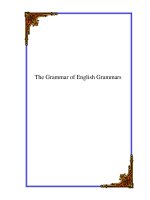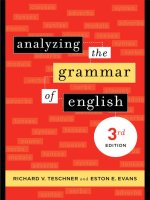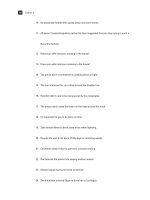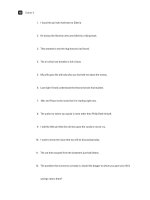The complementation of English transitive verbs
Bạn đang xem bản rút gọn của tài liệu. Xem và tải ngay bản đầy đủ của tài liệu tại đây (461.3 KB, 72 trang )
BỘ GIÁO DỤC VÀ ĐÀO TẠO
TRƯỜNG ĐẠI HỌC DÂN LẬP HẢI PHÒNG
------------------------------
ISO 9001 : 2008
KHÓA LUẬN TỐT NGHIỆP
NGÀNH: NGOẠI NGỮ
HẢI PHÒNG - 2010
HAIPHONG PRIVATE UNIVESITY
FOREIGN LANGUAGES DEPARTMENT
GRADUATION PAPER
A STUDY ON THE COMPLEMENTATION OF
ENGLISH TRANSITIVE VERBS
By:
Bùi Thị Dương
Class:
Na1001
Supervisor:
Nguyễn Thị Thu Hương, B.A
HAI PHONG - 2010
BỘ GIÁO DỤC VÀ ĐÀO TẠO
TRƯỜNG ĐẠI HỌC DÂN LẬP HẢI PHÒNG
--------------------------------------
Nhiệm vụ đề tài tốt nghiệp
Sinh viên: ............................................................Mã số:............................
Lớp: .............................Ngành:....................................................................
Tên đề tài: .................................................................................................
..................................................................................................
.................................................................................................
..................................................................................................
Nhiệm vụ đề tài
1. Nội dung và các yêu cầu cần giải quyết trong nhiệm vụ đề tài tốt nghiệp
( về lý luận, thực tiễn, các số liệu cần tính toán và các bản vẽ).
……………………………………………………………………………..
……………………………………………………………………………..
……………………………………………………………………………..
……………………………………………………………………………..
……………………………………………………………………………..
……………………………………………………………………………..
……………………………………………………………………………..
2. Các số liệu cần thiết để thiết kế, tính toán.
……………………………………………………………………………..
……………………………………………………………………………..
……………………………………………………………………………..
……………………………………………………………………………..
……………………………………………………………………………..
……………………………………………………………………………..
……………………………………………………………………………..
……………………………………………………………………………..
3. Địa điểm thực tập tốt nghiệp.
……………………………………………………………………………..
……………………………………………………………………………..
…………………………………………………………………………….
CÁN BỘ HƯỚNG DẪN ĐỀ TÀI
Người hướng dẫn thứ nhất:
Họ và tên:.............................................................................................
Học hàm, học vị:...................................................................................
Cơ quan công tác:.................................................................................
Nội dung hướng dẫn:............................................................................
Người hướng dẫn thứ hai:
Họ và tên:.............................................................................................
Học hàm, học vị:...................................................................................
Cơ quan công tác:.................................................................................
Nội dung hướng dẫn:............................................................................
Đề tài tốt nghiệp được giao ngày 12 tháng 04 năm 2010
Yêu cầu phải hoàn thành xong trước ngày 10 tháng 07 năm 2010
Đã nhận nhiệm vụ ĐTTN
Đã giao nhiệm vụ ĐTTN
Người hướng dẫn
Sinh viên
Hải Phòng, ngày tháng năm 2010
HIỆU TRƯỞNG
GS.TS.NGƯT Trần Hữu Nghị
PHẦN NHẬN XÉT TÓM TẮT CỦA CÁN BỘ HƯỚNG DẪN
1. Tinh thần thái độ của sinh viên trong quá trình làm đề tài tốt nghiệp:
……………………………………………………………………………..
……………………………………………………………………………..
……………………………………………………………………………..
……………………………………………………………………………..
……………………………………………………………………………..
……………………………………………………………………………..
2. Đánh giá chất lượng của khóa luận (so với nội dung yêu cầu đã đề ra
trong nhiệm vụ Đ.T. T.N trên các mặt lý luận, thực tiễn, tính toán số
liệu…):
……………………………………………………………………………..
……………………………………………………………………………..
……………………………………………………………………………..
……………………………………………………………………………..
……………………………………………………………………………..
……………………………………………………………………………..
……………………………………………………………………………..
3. Cho điểm của cán bộ hướng dẫn (ghi bằng cả số và chữ):
……………………………………………………………………………..
……………………………………………………………………………..
……………………………………………………………………………..
Hải Phòng, ngày ….. tháng ..… năm 2010
Cán bộ hướng dẫn
(họ tên và chữ ký)
NHẬN XÉT ĐÁNH GIÁ
CỦA NGƯỜI CHẤM PHẢN BIỆN ĐỀ TÀI TỐT NGHIỆP
1. Đánh giá chất lượng đề tài tốt nghiệp về các mặt thu thập và phân tích tài liệu,
số liệu ban đầu, giá trị lí luận và thực tiễn của đề tài.
2. Cho điểm của người chấm phản biện :
(Điểm ghi bằng số và chữ)
Ngày.......... tháng......... năm 2010
Người chấm phản biện
ACKNOWLEGEMENT
First of all, I wish to send my sincere thanks to my supervisor Mrs. Nguyen
Thi Thu Huong for her valuable guidance, helpful suggestions and critical
feedback throughout the study.
Also, I would like to acknowledge my gratitude to all the lecturers in
Foreign Language Department, Haiphong Private University for their useful
lessons from which I have benefited a lot for the accomplishment of this study.
Last but not least, I would like to express my special thanks to my loving
family, and my close friends who offered me their love, care, support and
encouragement so that I could accomplish my study.
Hai Phong, June 2010
Bui Thi Duong
Symbols and abbreviations
S:
Subject
V:
Verb
Co:
Object complement
O:
Object
NP:
Noun phrase
Pron:
Pronoun
AdjP:
Adjective phrase
PrepP:
Prepositional Phrase
Cl:
Clause
BrE:
British English
PrepO:
Prepositional Object
Monotrans:
Monotransitive verb
Ditrans:
Ditransitive verb
Complex-trans: Complex transitive verb
Aux:
Auxiliary verb
Lex:
Lexical verb
Cur.A:
Current Attribute
Res.A:
Result Attribute
Vprep:
Prepositional verb
Vphrasal-prep :
Phrasal-prepositional verbs
to-inf:
to-infinitive
bare-inf:
bare-infinitive
*
Incorrect sentence
[1; 9] :
[number of the book in the reference; page].
TABLE OF CONTENTS
Acknowledgement
Symbols and abbreviations
PART ONE: INTRODUCTION ............................................................................ 1
1. Rationale................................................................................................................ 1
2. Aims of the study .................................................................................................. 1
3. Scope of the study ................................................................................................. 2
4. Methods of the study ............................................................................................. 2
5. Design of the study................................................................................................ 2
PART TWO: DEVELOPMENT ........................................................................... 3
CHAPTER ONE: THEORETICAL BACKGROUND ....................................... 3
1.1. Verb in English .................................................................................................. 3
1.1.1. Definition of English verb ...................................................................... 3
1.1.2. Classification of English verb ................................................................. 4
1.1.2.1. According to functions of verb ...................................................... 4
1.1.2.2. According to forms of verb ............................................................ 7
1.1.2.3. According to meaning of verb ....................................................... 8
1.1.2.4. According to complementation of verb ......................................... 9
1.2. Object in English .............................................................................................. 13
1.2.1. Definition of object .............................................................................. 13
1.2.2. Classification of object ......................................................................... 14
1.2.3. Realization of object ............................................................................. 14
1.2.4. Position of object .................................................................................. 16
1.3 Object complement ........................................................................................... 17
1.3.1. Definition of object complement .......................................................... 17
1.3.2. Position of object complement.............................................................. 18
1.4. Adverbial .......................................................................................................... 18
CHAPTER TWO: THE COMPLEMENTATION OF ENGLISH
TRANSITIVE VERB ............................................................................................ 21
2.1. Monotransitive complementation ................................................................... 21
2.1.1. Noun phrase as direct object ................................................................. 21
2.1.2. Finite clause as direct object ................................................................. 23
2.1.3. Non-finite clause as direct object .......................................................... 27
2.2. Ditransitive complementation .......................................................................... 31
2.2.1. Noun phrases as both indirect and direct object ................................... 31
2.2.2. Noun phrase as indirect object and finite clause as direct object ......... 36
2.2.3. Noun phrase as indirect object & non-finite clause as direct object .... 39
2.3. Complex transitive complementation .............................................................. 41
2.3.1. Noun phrase as direct object and adjective as object complement ....... 41
2.3.2. Noun phrase as both direct object and object complement .................. 43
2.3.3. Noun phrase as direct object and adverbial ....................................... ...45
2.3.4. Noun phrase as direct object and non-finite as object complement ..... 45
CHAPTER
THREE:
COMMON
MISTAKES
MADE
BY
VIETNAMESE LEARNERS IN USING ENGLISH TRANSITIVE
VERB COMPLEMENTATION AND SUGGESTED SOLUTIONS .............. 51
3.1. Common mistakes made by Vietnamese learners ........................................... 51
3.2. Suggested solutions .......................................................................................... 56
PART THREE: CONCLUSION ......................................................................... 59
References .............................................................................................................. 60
PART I: INTRODUCTION
1.
Rationale
We all know that English is widely spoken all around the world draws
the attention of many linguists. Therefore, becoming a fluent speaker of
English is also one of the essential demands of most English learners.
However, it is not easy to achieve this because English can sometimes cause
them a lot of troubles with its grammar, structures, vocabularies, and
pronunciation, etc in which English grammar has the great importance and the
certain difficulty.
In English Grammar, the English verb has always been the element that
causes much more trouble to learners than any other ones in the sentence
because it provides the power of the sentence. When I could use it quite
fluently, the next complexity set up. I began to be confused of its
complementation. Therefore, I have decided to study on complementation of
verbs in general, and the complementation of transitive verbs in particular.
With this study, I wish to have a deep knowledge of English transitive
verbs as well as their complementation in order to help learners who are
interested in English Grammar can distinguish clearly. That is the reason why
I have chosen the topic “The complementation of English transitive verbs”
for my graduation paper.
2. Aims of the study
The study is conducted to help readers understand the syntactic function
of transitive complementation more clearly. With this trend, the study will
serve three purposes:
To present and classify English verbs according to their function, form,
meaning, and complementation.
To describe and analyze Monotransitive, Ditransitive and Complex
transitive verbs and their complementation.
1
To give common mistakes made by Vietnamese learners and suggest
solutions for teachers and students in teaching and learning transitive verb
complementation.
3. Scope of the study
Monotransitive, Ditransitive and Complex transitive verbs and their
complementation are very complicated, so giving a full theory and description
is impossible. Therefore, my study will concentrate on describing and
analyzing the most common structures and patterns.
4. Methods of study
To achieve the aims, my strategies are used as follows:
Reviewing the documents relating to Monotransitive, Ditransitive and
Complex transitive verbs and their complementation.
Giving and analyzing examples basing on the clause and sentence scale.
Analyzing the learners‟ problems in using English transitive verbs and
their complementation so that suggestions and solutions can be made.
5. Design of the study
The study begins with acknowledgements, table of contents, and symbols
and abbreviations.
The main body of the study is divided into three parts:
- Part one is introduction including rationale, aims, scope, methods and
design of the study.
- Part two is development, which consists of three chapters:
Chapter one discusses the theoretical background of English verb, object,
object complement and adverbial.
Chapter two describes and analyzes the complementation of English
transitive verbs.
Chapter three is about the common mistakes made by Vietnamese
learners in using English transitive complementation and the suggested
solutions.
- Part three is conclusion which presents the view of the study and
references puts the end to it.
PART TWO: DEVELOPMENT
CHAPTER ONE: THEORETICAL BACKGROUND
1.1. Verbs in English
1.1.1. Definition of English verb
English always composes of units which can be referred to as parts of
speech. They are article, pronoun, noun, adjective, adverb and verb, so on.
Grammatically, the verb is the most complex. The classification of parts of
speech depends on some factors including the type of meaning that words
express, the type of affixes that they take and the types of structure in which
they occur.
According to L.G Alexander (1988) “A verb is a word or a phrase which
expresses the existence of a state or the doing of an action”.
[4; 159]
For example:
- Using a verb to express the existence of a state:
She looks tired
She is beautiful
- Expressing the doing of an action:
He puts sugar in my tea
They have played for hours
Another definition, Sylvia Chalker (1990) shared the view that: “Verbs
are defined partly by position/function and partly by inflection”
[8;75]
To oversimplify greatly, we can say that any word that fulfils the
following two conditions is a verb.
Position: Any single word that can fit into one or more of the following
patterns and make a complete sentence (with no further word)
Inflection: Any word that has a set of inflection similar to the following:
work – worked – worked – works – working
Jack Richard (1985) gave the definition of the verb as follows: (In
English) a word which, (a) occurs as part of the Predicate of a sentence. (b)
carries markers of grammatical categories such as tense, aspect, person,
number, and mood, and (c) refers to an action or state.
[9;305]
This definition of Jack Richard, it is probably the most detail one in the
three definitions above. It seems to be the collection of many opinions about
the verb.
For example:
He wrote a letter
I wish I would become a teacher
In these examples, we can see that verbs “wrote” and “wish” are (a) the
beginning of the predicate of the sentences and:
+ The verb “wrote” (b) carries markers of past tense- simple aspect - 3rd
person singular - indicative mood; (c) it is an action.
+ The verb “wish” (b) carries markers of present tense - simple aspect - 1st
person singular - subjunctive mood; and (c) it is a state.
From the definitions of some linguists above, I can understand that a
verb is generally a word that expresses action or state of being. They are an
essential part of a complete sentence and it has markers of grammatical
categories.
1.1.2. Classification of verb
There are many different classifications of an English verb depending on
different criteria. However, verbs are classified according to four main
characteristics as follows:
1.1.2.1. According to function of verb
According to their functions, there are two types of verbs. They are
lexical verbs and auxiliary verbs.
a) Lexical verbs
Lexical verbs are those verbs that denote action or state.
Lexical verbs (eg: run, eat, think) function only as main verbs.
[2; 104]
Because lexical verb is the main verb of the sentence and all verbs
include a lexical verb, there are hundreds of different lexical verbs.
For example:
She is very beautiful (state)
She dislikes apples (state)
He kicks the ball (action)
There are two kinds of lexical verbs. They are full lexical verbs and
catenative lexical verbs:
Full lexical verb
Catenative lexical verb
They are the verbs refering to an There are many verbs, which refer not
activity and having a progressive to an activity but to a state or
form to indicate duration.
condition. The sense of duration is a
For example:
part of the lexical meaning of the
It rained a lot last month
verb, and there is for this reason no
It has been raining a lot for 2 need for a progressive form to
indicate
days
duration.
This
subgroup
includes: contain, belong, matter,
own, consist, depend, deserve.
For example:
It belongs to her
It contains butter
The different forms of lexical verbs. There are five forms judged by their
uses in the verb phrase
V
V-s
V-ed1
(base)
(3rd person)
(past)
go
goes
went
V-ing
V-ed2
(participles)
going
gone
work
works
worked
be
am, is, are
was, were
working
worked
being
been
b) Auxiliary verbs
Auxiliary verbs occur before a main verb and qualify the meaning of the
main verb.
[2; 103]
On the other hand, auxiliary verbs are those that help complete the
meaning of the verb phrase.
For example:
She can do anything she likes
Aux Lex
They have got married at this church
Aux Lex
Auxiliary verbs can be subdivided into primary and modal auxiliaries.
(i) Primary auxiliaries
Primary auxiliaries (be, have, and do) can function as both auxiliary and
main verbs.
[2; 104]
For example:
Functions
Primary verbs
Be
Have
Do
(ii) Modal auxiliaries
Main verb
He is lazy
Auxiliary
She is watering in the garden
Everyone has freedom Charlie has passed for 20
years
They do nothing
What do you do in the
evening?
Modal auxiliaries (can, could, shall, should, will, would, may, might,
must) function only as auxiliary verbs.
[2; 104]
For example:
You should take drugs immediately
In addition, there is a number of marginal auxiliaries (dare, need, ought
to, used to) that shares some of the characteristics of the auxiliaries, and a
large group of semi-auxiliaries (auxiliaries-like verbs) that conveys similar
notions of time, aspect, and modality such as be going to, have to, had to.
For example:
Children used to like sweet (1)
We have to finish our work before 5 p.m (2)
“Used to” functions as only auxiliary in this sentence (1) and the semiauxiliary “have to” in the example (2) used in the present simple tense to
express a speaker‟s duty.
1.1.2.2. According to form of verb
The verb forms operate in finite and non-finite verb phrases, which are
distinguished as follows:
a. Finite verb phrases have tense distinction
For example:
We study at Haiphong Private University
We studied at Haiphong Private University
b. Finite verb phrases occur as the verb element of a clause. There is
person and number concord between the subject and the finite verb. Concord
is particularly overt with “be”:
I + am
You/we/they + are
He/she/it + is
With most lexical verb, concord is restricted to a contrast between 3rd
and non-3rd person singular present.
For example:
He goes to work every night
They go to work every night
With the modal auxiliaries there is, however, no concord:
For example:
I/you/we/they can play the piano
c. Finite verb phrases have mood. It contrast to the unmarked indicative
mood, we distinguish the marked moods imperative and subjunctive.
d. The non-finite forms of the verb are the infinitive (to work). The -ing
participle (working), and the -ed participle (worked). Non-finite verb phrases
consist of one or more such items.
Finite verb phrases
Non-finite verb phrases
He work very hard
To work hard is good
He is working
I saw him working
He had been punished before
Having been punished before,
he was very afraid
1.1.2.3. According to meaning of verb
According to their meaning, the verbs are classified into two types. They
are dynamic and stative verbs.
a) Dynamic verbs
According to Alexander (1992), “Dynamic verbs, refer to actions which
are deliberate or voluntary or they refer to changing situations that is to
activities which have a beginning and an end. Dynamic verbs can be used in
progressive as well as simple forms”.
[4;160]
For example:
She does the homework everyday
She is doing the homework now
b) Stative verbs
A group of verbs, which refer to the states of affairs (Eg: be, belong,
know, see) are called stative verbs. They do not normally occur in the
progressive form (only in the simple form in all tenses). We can think of
“states” in categories like:
Feeling, emotions: Like, love, admire, adore, hope, mean, dislike,
doubt, envy, hate, etc
Thinking, believing: Know, disbelieve, think, understand, wonder,
believe, agree, find, imagine, etc
Wants, preferences: Desire, fancy, need, prefer, require, want, wish,
etc
Perception and senses: catch (=understand), hear, notice, observe,
perceive, see, smell, taste, etc
Being, seeming, having, owning: appear, seem, belong, own, possess,
sound (seem),etc
For example:
* They all understand my ideas
*They are understanding my ideas
There are, however, verbs which can be either stative or dynamic. It can
only be realized when they are in sentence.
For example:
She looks tired (stative)
She is looking at the picture (dynamic)
1.1.2.4. According to complementation of verb
Verbs complementation refers to the number and type of Objects and
complements that follow particular verbs or classes of verbs, and the syntactic
structures that verbs enter into. The term complement is used when referring
to complementation in general. When capitalized, complement refers to
specific elements of clause structure.
According to verb complementation, verbs are classified into intensive
verbs and extensive verbs.
a) Intensive verbs
Intensive verbs are the ones which often denote intensive relationship.
They can take a subject complements and an obligatory adverbial. So, its
sentence types are SVC and SVA. Intensive verbs do not take any Object. It
presents
the
relationship
between
the
Subject
and
the
Subject
Complementation. The verbs in sentences with Subject Complement is a
“copular” (or linking verb), which of itself has little meaning but functions as
a link between the Complement and the Subject.
There are two subgroups:
Current intensive includes be, appear, smell, feel, remain, keep, look.
For example:
She is a good student
Cs
A light appeared at the end of the tunnel
A (obligatory)
Resulting intensive includes come, grow, make, turn, get, go, become.
For example:
It is turning hot
Cs
They came to a river
A (obligatory)
b) Extensive verbs
Extensive verbs are those that extent their meaning to a new entity, of
which the present helps complete the meaning of the action or state.
For example:
She only recognized me (state)
Some people are dancing (action)
Extensive verbs may be intransitive and transitive
Intransitive verbs
Verbs which do not take Objects or intensive complements are
intransitive. Some are almost always intransitive (snow, vanish). Other
represent intransitive uses of basically transitive verbs (eat, drive, read). In
some types there is corresponding transitive use; in others, not. Intransitive
verbs take the sentence types SV.
For example:
The child cried
My mother is cooking in the kitchen
There are two subclasses of intransitive verbs:
Simple such as come, go, work, die, etc
Common V intransitive
Derived such as return, retire, etc
Phrasal Vintransitive such as go out, take off, give in, grow up, etc
For example:
They are coming
A close friendship gradually grew up between them
Transitive verbs
Verbs which take Objects or Complements are transitive.
Most of extensive verbs are transitive, and they can be Monotrasitive,
Ditransitive, or Complex transitive.
(i) Monotransitive verbs
Monotransitive verbs are the ones which have only a direct object and
take the sentence types SVO.
+ Verbs used in monotransitive function require a Direct Object, which
may be a noun phrase, a finite clause, or a non-finite clause. In addition to
these categories, the verb may be a prepositional verb or phrasal prepositional
verb, which for our present purposes will be treated as analogous to a verb
with a Direct Object.
+ There are four subgroups of Monotransitive verbs:
Simple V transitive such as ask, speak, write, answer, build, etc
For example:
You have not yet answered my question
Phrasal Vmonotrans such as turn down, set up, give up, make up, etc
For example:
At last, he decided to give up his job
Prepositional Vmonotrans such as look after, think of, depend on, etc
For example:
Students mainly depends on their parents
Phrasal-prepositional Vmonotrans such as cut down on, get on with, live
up to, look up to, look down on, catch up with, etc
For example:
I‟m looking forward to the weekend
I would still end up with a lot of money
(ii) Ditransitive verbs
Ditransitive verbs are the ones which a direct object and an indirect or
benefactive object. Ditransitive verbs take the sentence type SVOO.
There are two subgroups f ditransitive verbs:
Simple Vditrans such as take, buy, find, make, lend, pay, etc
For example:
He gave her the book
Prepositional Vditrans such as accuse of, provide with, remind of, charge
with, compare to, congratulate on, convince of, deprive of, inform of,
introduce to, punish for, rob of, treat to, etc
For example:
He reminds me of the next plans
(iii)Complex transitive verbs
Complex transitive verbs are the ones which have one Object and one
intensive Complement. The Direct Object generally represents a person or
thing, and the Object complement adds the information about this entity from
the standpoint of the Subject. This information can describe or identify the
referent of the Direct Object by means of some attribute; or express a
circumstance or situation in which the referent is said to be.
[5;93]
Complex transitive verbs take the sentence type SVOC and SVOA.
+ With SVOC type, the verbs which take this type are usually factual
verbs, causative verbs, verbs of perception and other verbs.
Factual verbs such as imagine, like, find, think, keep, etc
For example:
He keeps the garden beautiful
Od
Co
Causative verbs such as have, let, make, etc
For example:
His parents make him stay at home at night
Od
Co
Verbs of perception such as watch, want, notice, observe, etc
For example:
Do you want the chicken hot or cold?
Od
Co
Other verbs such as elect, consider, interpret, class, accept, etc
For example:
His colleagues consider him too old for the job
Od
Co
We elected Nam (as) the monitor
Od
Co
+ With SVOA type, it normally includes put, place, stand, hang, etc
For example:
They have hanged the picture on the wall
Od
Co
1.2. Object
1.2.1. Definition of Object
According to Jack Richard in his “Longman Dictionary of Applied
linguistics” give a definition of the Object as “the noun, noun phrase or clause









